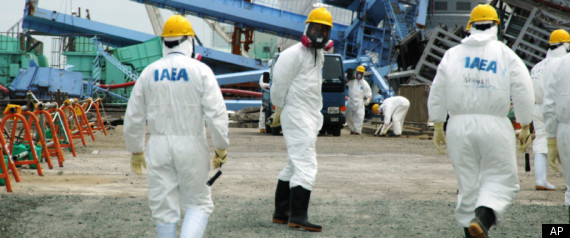You are here
Japan Nuclear Crisis: IAEA Report Finds Country Underestimated Tsunami Risk For Nuclear Plants
Primary tabs

In this May 27, 2011 photo released by the International Atomic Energy Agency, or IAEA, members of the IAEA fact-finding team in Japan visit the Fukushima Dai-ichi nuclear plant in Okuma, Fukushima prefecture, northern Japan. (AP Photo/IAEA)
Reuters - June 1, 2011
TOKYO, June 1 (Reuters) - Japan underestimated the risk of tsunamis and needs to closely monitor public and workers' health after the crisis at the Fukushima Daiichi nuclear plant, a team of international safety inspectors said in a preliminary review of the world's worst nuclear disaster since Chernobyl.
The report, from an International Atomic Energy Agency (IAEA) team led by Britain's top nuclear safety official Mike Weightman, highlighted some of the well-documented weaknesses that contributed to the crisis at Fukushima when the plant, 240 km (150 miles) north of Tokyo, was hit by a massive earthquake and then a tsunami in quick succession on March 11.
Those start with a failure to plan for a tsunami that would overrun the 5.7-metre (19 ft) break wall at Fukushima and knock out back-up electric generators to four reactors, despite multiple forecasts from a government agency and operator Tokyo Electric Power Co's own scientists that such a risk was looming.
The IAEA team said Japan's crisis offered several lessons for the nuclear industry globally, including that plant operators should regularly review the risks of natural disasters and that "hardened" emergency response centres should be established to deal with accidents.
"The tsunami hazard for several sites was underestimated," the report's three-page summary said.
"Nuclear plant designers and operators should appropriately evaluate and provide protection against the risks of all natural hazards."
Goshi Hosono, an aide to Prime Minister Naoto Kan, accepted the report, marking the first step in an effort by Japanese officials to show that the lessons learned from Fukushima can be applied to make its remaining reactors safe.
Hosono said the government would need to review its nuclear regulatory framework.
The IAEA team will submit its findings to a ministerial conference on nuclear safety in Vienna from June 20-24.
"We had a playbook, but it didn't work," said Tatsujiro Suzuki, a nuclear expert and vice chairman of Japan's Atomic Energy Commission.
HIGH STAKES
The economic stakes are high. Japan is operating only 19 of its pre-Fukushima tally of 54 reactors. Unless local officials can be convinced that Tokyo has a plan to make the others resistant to the kind of blackout that plunged Fukushima into meltdown, more plants will drop off-line for maintenance.
In the worst case, all of Japan's reactors could be shut down by the middle of 2012. That would take out 30 percent of the nation's electricity generation and raise the risk of deeper, near permanent power rationing, officials say.
The Fukushima accident has forced more than 80,000 residents from their homes and raised deepening concerns about the safety of nearby children, workers battling to stabilise the reactors and the food supply as radiated water leaks from the site.
In the report, the IAEA team urged Japan to follow up with monitoring of worker and public health.
The crisis has also diverted attention and resources from rebuilding after the quake and tsunami that killed about 24,000 people in northern coastal Japan.
Experts who have reviewed the Fukushima incident say the IAEA report represents a starting point in the debate over what needs to be done to make nuclear plants safe in a country where the risks of earthquakes are still imperfectly understood.
"There are aspects of the planning for the safety of the Fukushima plant which are, in retrospect, very stupid, and show a lack of imagination," said Kim Kearfott, a University of Michigan nuclear safety expert who toured Japan on her own this week. "The nuclear industry can do better than this."
As the uranium fuel in the No. 1 reactor began heating towards meltdown on March 11, Tokyo Electric (Tepco) officials grappled with outages of key safety equipment because of the loss of power to the plant.
With gauges black from Fukushima, officials in Tokyo monitoring the expected radiation risk faced a related problem. Complicated software to model the expected plume of debris from a Fukushima explosion had been set up to run with precise data rather than rough assumptions.
By early on March 12, officials at the Ministry of Education and Technology had fixed the glitch and sent a projected radiation map to Prime Minister Kan's office, but the data was never released to the public.
Meanwhile, it was dangerously unclear who was in charge on the ground at Fukushima. Tepco's chairman was in China, the utility's president was grounded in western Japan on a personal trip. Sakae Muto, the ranking Tepco official, spent the night of the quake huddled with mayors of small towns near Fukushima, giving them formal notice of the accident rather than joining the command centre.
The plant's chief operating officer, Masao Yoshida, ignored an order to stop injecting seawater into the No. 1 reactor based on a request from Kan's office. Experts say Yoshida made the right call, but say the confusion underscored the bigger problems in the early response to the accident.
"It was impossible for the system to work as it had been set up," said Suzuki, who believes Japan's nuclear industry will now have to show it can manage and contain the most improbable accidents at all of its remaining reactors to win public trust. "Unless they can show that, it's going to be very hard."
Others say Japan needs to show it will act on the toughest advice from critics, including long-delayed steps to make its nuclear regulatory agency independent of the politically powerful utility industry.
"Japanese nuclear operations need to be upgraded based on international advice," said Kearfott. "Much of this advice was ignored in the past."
http://www.huffingtonpost.com/2011/06/01/japan-nuclear-crisis-iaea-report_n_869508.html



Recent Comments